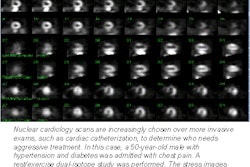Understaffing and inadequate training are some of the problems faced at 14 nuclear medicine departments in the district general hospitals of the South Thames region of London, according to a study in the latest issue of the British Journal of Radiology.
"Despite the Royal College of Radiologists' recommendation for 12,500 maximum examination workload per [full-time] radiologist, imaging demand continues to exceed capacity. With such demands, it is vital that radiologists with subspecialty interests have sufficient contractual sessions to enable clinical and legal standards to be met," the study stated (BJR, August 2001, Vol. 74:884, pp. 715-719).
Four of the small departments that were studied provided services without formally contracted radiologist sessions in nuclear medicine in the radiologist's job plans. Three of the medium-sized departments analyzed had closer matches between sessions contracted and those actually worked. Only one of the departments studied had contracted session commitments equal to the recommendation of the Nuclear Medicine Committee of the Royal College of Physicians (NMCRCP), according to the study.
Researchers also found that one department averaged 1,413 studies in a three-day work week, and full-time departments varied between 1,724 and 3,541 studies, with a mean of 2,305 studies per week. All of the departments averaged 2,358 studies per year.
"Of the hospitals classified as small district general hospitals, the average workload of 2,327 studies is significantly higher than outlined in the NMCRCP report, and closer to expected numbers for a medium-sized district general hospital," the study stated.
Four of the hospitals studied did not have designated consultant sessions for nuclear medicine, and only two hospitals, both oncology centers, performed therapy sessions.
"In most hospitals, the total sessional commitment is significantly greater than that contracted. In hospitals with less than one contracted session, the service is maintained by noncontracted out-of-hours and ad hoc arrangements," according to the study.
One medium-sized district general hospital had a part-time bone densitometry department that scanned 1,070 patients per year. All departments, with the exception of one, functioned with radiographers rather than technicians. Researchers also found that 43% of the hospitals studied only had a day or half a day per month of physicist involvement.
"Adequate sessional provision is present in only 7% of [the centers]. It is clear that in 29% of the centers, little or no formal sessional time is allocated, and reporting is frequently performed at the end of a busy clinical radiological day," according to the study.
In related news, Reuters Health reported that the U.K.’s Health Department received a flood of phone calls and e-mails in anticipation of a September advertising campaign by the state-funded National Health Service (NHS). The campaign, which focuses on addressing the lack of human resources and expanding the workforce of the NHS, will target doctors in seven European countries, including Denmark, Finland, Germany, Greece, Holland, Sweden, and Switzerland. Other countries targeted include the U.S., Canada, Australia, New Zealand, and the Middle East (Reuters Health, August 28, 2001).
By Jennifer LungAuntMinnie.com staff writer
September 12, 2001
Copyright © 2001 AuntMinnie.com



















